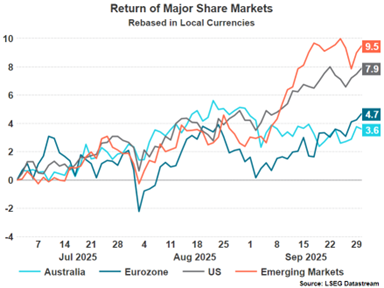Quarterly Update: September 2025
Here are the key points from our Market and Economic Update for the September quarter 2025:
- Equity markets gained: Global equity markets posted strong gains in the third quarter, led by robust performances in the US, Australia, China, Japan and the UK, with positive sentiment driven by technology, commodities, and supportive fiscal and monetary policies.
- Bond prices were volatile: Fixed income markets were mixed, reflecting varied economic outlooks, inflation concerns, and central bank actions across major regions, while credit spreads tightened further.
- Mixed FX movements: The US Dollar strengthened due to resilient economic data and fewer than expected rate cuts, while the Australian Dollar also gained value, supported by rising commodity prices and a hawkish Reserve Bank. Major currencies like the Yen, Euro, and Pound faced headwinds from weak growth and low interest rates.


